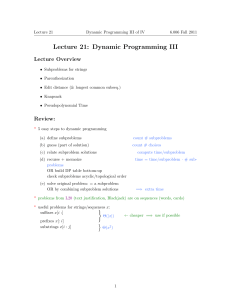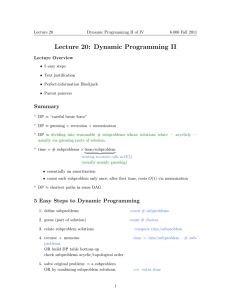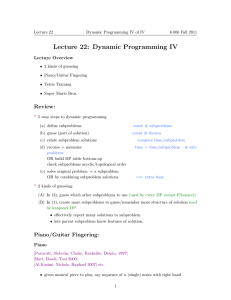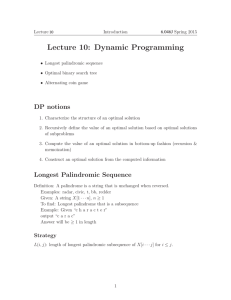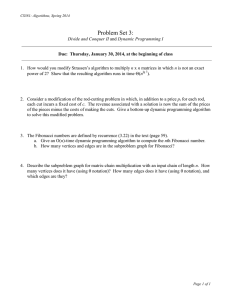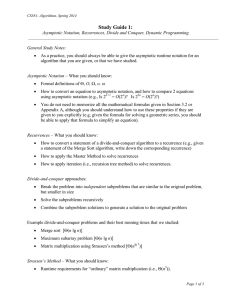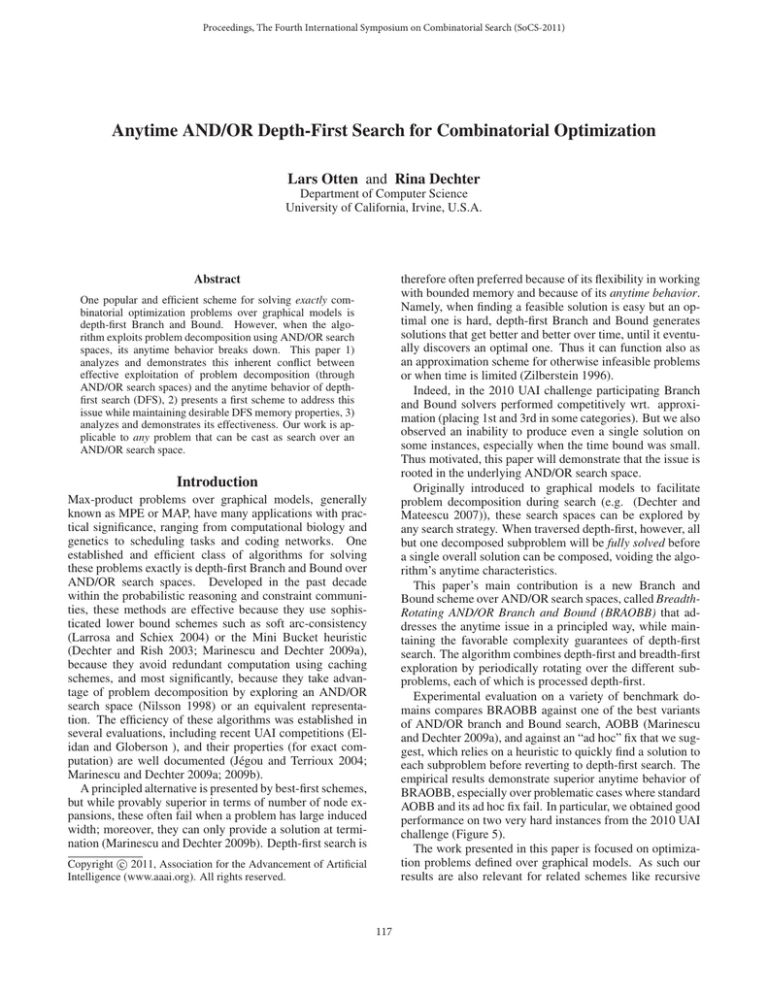
Proceedings, The Fourth International Symposium on Combinatorial Search (SoCS-2011)
Anytime AND/OR Depth-First Search for Combinatorial Optimization
Lars Otten and Rina Dechter
Department of Computer Science
University of California, Irvine, U.S.A.
therefore often preferred because of its flexibility in working
with bounded memory and because of its anytime behavior.
Namely, when finding a feasible solution is easy but an optimal one is hard, depth-first Branch and Bound generates
solutions that get better and better over time, until it eventually discovers an optimal one. Thus it can function also as
an approximation scheme for otherwise infeasible problems
or when time is limited (Zilberstein 1996).
Indeed, in the 2010 UAI challenge participating Branch
and Bound solvers performed competitively wrt. approximation (placing 1st and 3rd in some categories). But we also
observed an inability to produce even a single solution on
some instances, especially when the time bound was small.
Thus motivated, this paper will demonstrate that the issue is
rooted in the underlying AND/OR search space.
Originally introduced to graphical models to facilitate
problem decomposition during search (e.g. (Dechter and
Mateescu 2007)), these search spaces can be explored by
any search strategy. When traversed depth-first, however, all
but one decomposed subproblem will be fully solved before
a single overall solution can be composed, voiding the algorithm’s anytime characteristics.
This paper’s main contribution is a new Branch and
Bound scheme over AND/OR search spaces, called BreadthRotating AND/OR Branch and Bound (BRAOBB) that addresses the anytime issue in a principled way, while maintaining the favorable complexity guarantees of depth-first
search. The algorithm combines depth-first and breadth-first
exploration by periodically rotating over the different subproblems, each of which is processed depth-first.
Experimental evaluation on a variety of benchmark domains compares BRAOBB against one of the best variants
of AND/OR branch and Bound search, AOBB (Marinescu
and Dechter 2009a), and against an “ad hoc” fix that we suggest, which relies on a heuristic to quickly find a solution to
each subproblem before reverting to depth-first search. The
empirical results demonstrate superior anytime behavior of
BRAOBB, especially over problematic cases where standard
AOBB and its ad hoc fix fail. In particular, we obtained good
performance on two very hard instances from the 2010 UAI
challenge (Figure 5).
The work presented in this paper is focused on optimization problems defined over graphical models. As such our
results are also relevant for related schemes like recursive
Abstract
One popular and efficient scheme for solving exactly combinatorial optimization problems over graphical models is
depth-first Branch and Bound. However, when the algorithm exploits problem decomposition using AND/OR search
spaces, its anytime behavior breaks down. This paper 1)
analyzes and demonstrates this inherent conflict between
effective exploitation of problem decomposition (through
AND/OR search spaces) and the anytime behavior of depthfirst search (DFS), 2) presents a first scheme to address this
issue while maintaining desirable DFS memory properties, 3)
analyzes and demonstrates its effectiveness. Our work is applicable to any problem that can be cast as search over an
AND/OR search space.
Introduction
Max-product problems over graphical models, generally
known as MPE or MAP, have many applications with practical significance, ranging from computational biology and
genetics to scheduling tasks and coding networks. One
established and efficient class of algorithms for solving
these problems exactly is depth-first Branch and Bound over
AND/OR search spaces. Developed in the past decade
within the probabilistic reasoning and constraint communities, these methods are effective because they use sophisticated lower bound schemes such as soft arc-consistency
(Larrosa and Schiex 2004) or the Mini Bucket heuristic
(Dechter and Rish 2003; Marinescu and Dechter 2009a),
because they avoid redundant computation using caching
schemes, and most significantly, because they take advantage of problem decomposition by exploring an AND/OR
search space (Nilsson 1998) or an equivalent representation. The efficiency of these algorithms was established in
several evaluations, including recent UAI competitions (Elidan and Globerson ), and their properties (for exact computation) are well documented (Jégou and Terrioux 2004;
Marinescu and Dechter 2009a; 2009b).
A principled alternative is presented by best-first schemes,
but while provably superior in terms of number of node expansions, these often fail when a problem has large induced
width; moreover, they can only provide a solution at termination (Marinescu and Dechter 2009b). Depth-first search is
c 2011, Association for the Advancement of Artificial
Copyright Intelligence (www.aaai.org). All rights reserved.
117
conditioning (Darwiche 2001) and value elimination (Bacchus, Dalmao, and Pitassi 2003) in the area of probabilistic reasoning, or BTD (Backtracking Tree Decomposition
(Jégou and Terrioux 2004)) in constraint optimization. We
point out, however, that the presented concepts carry over to
combinatorial AND/OR search spaces in general. Finally,
we note Interleaved Depth-First Search (Meseguer 1997),
which uses a similar idea of interleaved processing of different subtrees to overcome heuristic mistakes in general
heuristic search (i.e., not optimization).
The remainder of this paper is structured as follows: Section introduces the underlying concepts while Section identifies the central issue and provides empirical evidence. The
new algorithm BRAOBB is proposed in Section and its
properties analyzed. Section presents experimental results
and analysis before Section concludes.
(a)
Background
(b)
(c)
(d)
We consider a MPE (Most Probable Explanation, sometimes
also MAP, Maximum A Posteriori assignment)
problem over
a graphical model, (X, F, D, max, ) . F = {f1 , . . . , fr } is
a set of functions over variables X = {X1 , . . . , Xn } with
discretedomains D = {D1 , . . . , Dn } , we aim to compute
maxX i fi , the probability of the most likely assignment.
The set of function scopes implies a primal graph and, given
an ordering of the variables, an induced graph (where, from
last to first, each node’s earlier neighbors are connected)
with a certain induced width. Another closely related combinatorial optimization problem is the weighted constraint
problem, where we
aim to minimize the sum of all costs,
i.e. compute minX i fi . These tasks have many practical
applications but are known to be NP-hard.
The concept of AND/OR search spaces has recently been
introduced to graphical models to better capture the structure of the underlying graph during search (Dechter and Mateescu 2007). The search space is defined using a pseudo
tree of the graph, which captures problem decomposition:
D EFINITION 1. A pseudo tree of an undirected graph G =
(X, E) is a directed, rooted tree T = (X, E ) , such that
every arc of G not included in E is a back-arc in T , namely
it connects a node in T to an ancestor in T . The arcs in E may not all be included in E.
Figure 1: (a) Example primal graph of a graphical model
with six variables, (b) its induced graph along ordering d =
A, B, C, D, E, F , (c) a corresponding pseudo tree, and (d)
the resulting context-minimal AND/OR search graph.
2007). It was shown that, given a pseudo tree T of height h,
the size of the AND/OR search tree based on T is O(n · k h ),
where k bounds the variables’ domain size. The∗ contextminimal AND/OR search graph has size O(n· k w ) , where
w∗ is the induced width of the problem graph along a depthfirst traversal of T (Dechter and Mateescu 2007). Note that
in Figure 1(a) the AND nodes for B have two children each,
representing independent subproblems and thus demonstrating problem decomposition.
Given an AND/OR search space ST , a solution subtree
SolST is a tree such that (1) it contains the root of ST ; (2)
if a nonterminal AND node n ∈ ST is in SolST then all its
children are in SolST ; (3) if a nonterminal OR node n ∈ ST
is in SolST then exactly one of its children is in SolST .
AND/OR Branch and Bound (AOBB) is a state-ofthe-art algorithm for solving optimization problems such
as max-product over graphical models. The edges of the
AND/OR search graph can be annotated by weights derived
from the set of cost functions F in the graphical model; finding the optimal-cost solution subtree solves the stated optimization task. Assuming a maximization query, AOBB traverses the weighted context-minimal AND/OR graph in a
depth-first manner while keeping track of the current lower
bound on the maximal solution cost. A node n will be
pruned if this lower bound exceeds a heuristic upper bound
on the solution to the subproblem below n, often obtained by
solving a relaxed problem (e.g. through Mini Buckets (Kask
and Dechter 2001)). The algorithm interleaves forward node
expansion with a backward cost revision or propagation step
that updates node values (capturing the current best solution
to the subproblem rooted at each node), until search terminates and the optimal solution has been found. (Marinescu
and Dechter 2009a).
AND/OR Search Trees and Graphs : Given a graphical
model instance with variables X and functions F , its primal
graph (X, E) , and a pseudo tree T , the associated AND/OR
search tree consists of alternating levels of OR and AND
nodes. Its structure is based on the underlying pseudo tree
T : the root of the AND/OR search tree is an OR node labeled with the root of T . The children of an OR node Xi are AND nodes labeled with assignments Xi , xj that are
consistent with the assignments along the path from the root;
the children of an AND node Xi , xj are OR nodes labeled
with the children of Xi in T , representing conditionally independent subproblems.
Identical subproblems, identified by their context (the
partial instantiation that separates the subproblem from the
rest of the network), can be merged, yielding the contextminimal AND/OR search graph (Dechter and Mateescu
118
Anytime versus AND/OR
pedigree30x1, i10 (n=1289 k=5 w=21 h=108)
log(probability)
We will use AOBB to denote the algorithm above in its specific graphical models context as well as a generic name for
any depth-first Branch and Bound scheme over an AND/OR
search space. As a depth-first scheme one would expect
AOBB to quickly produce a non-optimal solution and then
gradually improve upon it, maintaining the current best one
throughout the search. However this ability is compromised
in the context of AND/OR search.
Specifically, in AND/OR search spaces depth-first traversal of a set of independent subproblems will solve to completion all but one subproblem before the last one is even considered. As a consequence, the first generated overall nonoptimal solution contains conditionally optimal solutions to
all subproblems but the last one. Furthermore, depending on
the problem structure and the complexity of the independent
subproblems, the time to return even this first non-optimal
overall solution can be significant, practically negating the
anytime behavior of depth-first search (DFS).
-136
-137
-138
-139
-140
-141
-142
-143
-144
increasing
decreasing
1
10
100
1000
10000
Search time in seconds
log(probability)
pedigree41x1, i7 (n=1062 k=5 w=33 h=100)
Subproblem Ordering
In certain cases, the above suggests a simple remedy: if decomposition yields only one large subproblem and several
smaller ones, the latter can be solved depth-first in relatively
little time, to be then combined with the incrementally improving solutions of the larger subproblem. Thus for anytime behavior an AOBB algorithm would need to process
independent subproblems from “easy” to “hard”.
To demonstrate the practical impact of subproblem orderings, we use a simple heuristic that takes the induced width
as a measure of subproblem hardness (motivated by its exponential role in the asymptotic complexity), i.e. we modify
AOBB such that subproblems with smaller induced width
will be processed first (in the general description of AOBB
the subproblem ordering is left unspecified).
Figure 2 contrasts the anytime performance of AOBB using this “increasing” subproblem order against the inverse
one (“decreasing”) by plotting the solution cost generated
as a function of time on two example problems (the dashed
horizontal line is the optimum cost); all other aspects of the
algorithm remain constant. Pedigree30x1 in particular features exactly one single complex subproblem and a number of relatively simple ones; in this case processing subproblems by increasing induced width right away produces
a non-optimal solution that improves rapidly. The inverse
order yields the first solution only after about 90 minutes –
the one complex subproblem has been fully solved and the
overall solution is already optimal. Pedigree41x1 has a similarly advantageous structure and thus yields similar results
– with the distinction that the inverse subproblem order does
not produce any solution at all within 24 hours.
In case of pedigree34x2, however, decomposition yields
two complex subproblems: the increasing subproblem order
still outperforms its inverse, yet it returns the initial solution
only after about 1,000 seconds. In fact, no possible subproblem ordering can lead to acceptable anytime behavior in this
case due to the structure of subproblems, clearly highlighting the limits of this approach.
-120
-122
-124
-126
-128
-130
-132
-134
-136
-138
-140
increasing
decreasing
1
10
100
1000
10000
Search time in seconds
log(probability)
pedigree34x2, i15 (n=2320 k=5 w=31 h=102)
-222
-224
-226
-228
-230
-232
-234
-236
-238
increasing
decreasing
1
10
100
1000
10000
Search time in seconds
Figure 2: Impact of subproblem ordering on AOBB. Specified for each network: number of variables n, max. domain
size k, induced width w along the chosen ordering, height of
the corresponding pseudo tree h.
Independent of anytime behavior, we point out that incorporating different subproblem orderings impacts the algorithm’s overall efficiency (i.e., the time to finding and proving an optimal solution): knowing the solution to one subproblem can aid the pruning of Branch and Bound in the next
one to varying degrees. However, this issue has not been
treated systematically in the literature for graphical models,
with sporadic experiments also suggesting an easy-to-hard
order, using some heuristic to determine subproblem complexity (Marinescu and Dechter 2009a). This general problem is outside the scope of the present paper, however.
Greedy Subproblem Dive
Another relatively straightforward remedy that can be
viewed as an “ad hoc” fix is the following: Every time de-
119
Algorithm 1 Breadth-Rotating AOBB
composition is encountered within the search space, we will
try to greedily find a single initial solution to each independent subproblem before successively solving each of them
to completion depth-first, through normal AOBB. To obtain this initial solution the algorithm can perform a greedy
“dive” into each subproblem by only considering one value
for each variable along the path (in case of the Mini Bucket
heuristic, it is easy to see that this is equivalent to a forward
pass over the bucket structure (Kask and Dechter 2001)).
Clearly, the choice of the dive path is crucial for the algorithm’s performance. Namely, if the chosen path leads
to a dead end (zero probability), the dive will be futile and
not yield a subproblem solution. And in fact experiments
in Section will demonstrate that the resulting performance
depends heavily on the quality of the heuristic, which often prevents satisfactory anytime behavior. In the next section we will therefore propose a new search strategy that
addresses the anytime issue over AND/OR search spaces in
a principled manner.
Given: Graphical model (X, F, D, max, ) and pseudo tree T
with root Xo , rotation threshold Z
Output: cost of optimal solution
1: ROOT ← {X0 } // generate root subproblem
2: push ROOT to end of GLOBAL
3: while GLOBAL= ∅
4:
LOCAL ← front(GLOBAL) // next subproblem in queue
5:
for z ← 1 to Z or until LOCAL = ∅
or until childSubprob(LOCAL) = ∅
6:
n ← top(LOCAL) // top node from current subproblem
7:
... // caching and pruning as in AOBB
8:
if n = Xi is OR node
9:
for xj ∈ Di
10:
create AND child Xi , xj 11:
add Xi , xj to top of LOCAL
12:
else if n = Xi , xj is AND node
13:
Y1 , . . . , Ym ← childrenT (Xi )
14:
generate OR children Y1 , . . . , Yr 15:
if m=1 // no decomposition
16:
push Y1 to top of LOCAL
17:
else if m > 1 // problem decomposition
18:
for r ← 1 to m
19:
NEW ← {Yr } // new child subproblem
20:
push NEW to back of GLOBAL
21:
if children(n)= ∅ // n is leaf
22:
propagate(n) // upwards in search space
23:
if LOCAL = ∅ // subproblem not yet solved
24:
push LOCAL to end of GLOBAL
25: return value(X0 ) // root node contains optimal solution
Breadth-Rotating AOBB
In the following we develop a new search scheme called
Breadth-Rotating AND/OR Branch and Bound (BRAOBB)
that addresses the issue of anytime performance over
AND/OR search spaces. It combines depth-first exploration
with the notion of “rotating” through different subproblems
in a breadth-first manner. Namely, node expansion still occurs depth-first as in standard AOBB, but the algorithm takes
turns in processing subproblems, each up to a given number
of operations at a time, round-robin style.
To motivate this approach, consider again that a solution
is represented by a solution tree over an AND/OR search
space, guided by a pseudo tree. A pure DFS scheme will
construct the different branches of a solution tree one by one,
ensuring optimality for each branch before moving to the
next. To restore anytime behavior, we instead aim to develop
all branches of the the solution tree “simultaneously”, which
we emulate by rotating through them.
More systematically, the algorithm repeats the following
high-level steps until completion:
different branches of the solution tree. The input parameter
Z gives this rotation threshold. Each subproblem is itself explored depth-first (via a local last-in-first-out stack of nodes,
LOCAL); whenever a new level of decomposition is encountered, as captured by the pseudo tree, the resulting child subproblems are pushed to the end of the global queue. Finally,
subproblems are only considered in the rotation if they don’t
currently have any child subproblems. The following example illustrated:
Example : Figure 3 demonstrates the scheme’s application (Z = 2) to the AND/OR search graph in Figure 1(d)
(assuming no pruning). Part (a) shows the first 12 nodes expanded during the first seven iterations of the outer while
loop as follows: (1) Taking the overall problem as subproblem P0, expand A and A, 0 before reaching the threshold
Z = 2. (2) With no decomposition so far rotation returns to
subproblem P0. Expand B and B, 0, yielding subproblems P1 and P2 rooted at C and E, respectively, which
are added to the queue. (3) Rotate to subproblem P1 and
expand C and C, 0. (4) Rotate to subproblem P2. Expand E and E, 0. (5) Rotate to subproblem P0 but skip
it at this point, since its child subproblems P1 and P2 are
still open. (6) Rotation moves to subproblem P1. Expand
D and D, 0, discover a leaf and propagate. (7) Rotate to
subproblem P2, expand F and F, 0 – which, as a leaf, is
propagated to yield the first overall solution.
Figure 3(b) illustrates how the search then proceeds to
take turns solving subproblems P1 and P2 to completion
1. Move breadth-first to next open subproblem P .
2. Process P depth-first, until either:
• P is solved optimally,
• P decomposes into child subproblems, or
• a predefined threshold of operations is reached.
The threshold is needed to ensure the algorithm does not
get stuck in one large subproblem (where the other two conditions do not occur for a long time). Furthermore, in order
to focus on a single solution tree at a time, a subproblem
is only considered “open” if it does not currently have any
child subproblems, as illustrated below.
Algorithm 1 gives more detailed pseudo code for the
scheme (with some details from standard AOBB omitted,
cf. (Marinescu and Dechter 2009a)). The key element
lies in rotating over the different subproblems of the search
space; by organizing these in a global first-in-first-out queue
(GLOBAL), we emulate breadth-first exploration across the
120
(a) Expansion of nodes 1–12
(b) Expansion of nodes 13–31
(c) Expansion of nodes 32–44
Figure 3: BRAOBB exploration (Z = 2) at different stages. Nodes are numbered in order of their expansion.
Second, the actual number of nodes explored by
BRAOBB might differ from plain AOBB (for both graph
and tree search), since the pruning behavior of the algorithm
can be impacted by the order in which nodes are explored
and subproblem solutions produced: On the one hand, solving a subproblem to completion before processing the next
(in AOBB) might allow the algorithm to calculate a tighter
upper bound using this optimal solution, resulting in better
pruning. On the other hand, exploring subproblems concurrently in BRAOBB might lead to a tighter overall lower
bound through combining solutions across subproblems as
they are discovered (in an anytime fashion).
Significance of Z : The rotation threshold Z keeps the
scheme from getting stuck in large subproblems, where the
other two “natural” rotation conditions would not occur for
a long time. As we will see in the next section, however, in
practical problems we typically encounter frequent subproblem branching. The Z threshold is thus practically never
reached and its value has little effect.
(nodes 13–22) before reopening subproblem P0. Expansion
23 yields two new independent subproblems P3 and P4; their
solution is depicted by nodes 24–41. After that subproblem P0 gets reopened, where expanding nodes 42–44 again
yields two new subproblems P5 and P6, and so forth.
Analysis of Breadth-Rotating AOBB
Complexity : We assume a graphical model with n variables whose domain size is bounded by k. Let w∗ be the
induced width of the problem along a given ordering and h
the height of the corresponding pseudo tree T . Despite the
breadth-first component the algorithm maintains the asymptotic complexity of standard AOBB:
T HEOREM 1. When searching an AND/OR search tree (i.e.,
without caching of redundant subproblems), BRAOBB has
time complexity O(n · k h ) and space complexity linear in
n . When searching an AND/OR search graph (with full
∗
caching), time and space complexity are O(n · k w ) .
Proof. BRAOBB explores the same underlying AND/OR
search space as standard AOBB, hence its asymptotic time
complexity remains unchanged, i.e. exponential in h for tree
and exponential in w∗ for graph search. Space complexity
for AND/OR graph search is dominated by the caching and
thus also remains unchanged exponential in w∗ . In case of
tree search, recall that subproblems with child subproblems
are not processed further. Therefore every variable will appear in at most one subproblem at any given time. And since
each subproblem is processed depth-first, i.e. in linear space,
the space across all subproblems is also linear in n.
Empirical Evaluation
To validate and compare the performance of the various
schemes we recorded their anytime behavior on a variety
of problem instances using a common variable ordering and
Mini Bucket heuristic for each instance (24 hour timeout),
subproblems were ordered by increasing width (cf. Section
). We ran “plain” AOBB, AOBB with the dive extension,
and BRAOBB; as a baseline we also included OR Branch
and Bound (without problem decomposition).
Our initial test set was comprised of 19 pedigree instances, 50 randomly generated grid networks, and 8 mastermind game instances, all part of the UAI 2008 evaluation.
To ensure the presence of more than one complex subproblem, we created additional versions of each network with
two and three identical copies connected at the root (signified by the “x2” and “x3” suffix, respectively), yielding a
total of 57 pedigree (each run with three different heuristics), 150 grid, and 24 mastermind instances and resulting in
over 60,000 CPU hours worth of experiments (enabled by a
320-core cluster).
Figure 4 presents results on eight instances with more
than one complex subproblem, on which plain AOBB does
poorly wrt. anytime. OR Branch and Bound finds an early
lower bound in three cases, but provides very little improve-
It is worth pointing out that these are worst-case bounds
that are often not met in practice, because the Branch and
Bound scheme is typically very efficient and prunes large
parts of the search space. In particular, the exponential memory bound for AND/OR graph search is usually not an issue
since only relatively few cache entries will be written.
Comparison with standard AOBB : First, we expect
that the anytime performance of BRAOBB will be robust
with respect to different subproblem orderings, since the algorithm is not forced to “commit” to a single subproblem –
which we identified as the main reason for the poor anytime
behavior of plain AOBB in Section . We will confirm this
experimentally in Section .
121
75-23-1x3, i20 (n=1587 k=2 w=34 h=115)
-50
-52
log(probability)
log(probability)
75-22-3x3, i20 (n=1452 k=2 w=32 h=94)
-43
-44
-45
-46
-47
-48
-49
-50
-51
-52
plain
dive
rotate
or
1
10
-54
-56
-58
plain
dive
rotate
or
-60
-62
-64
100
1000
10000
Search time in seconds
1
10
pedigree34x2, i15 (n=2320 k=5 w=31 h=102)
-220
-225
log(probability)
log(probability)
75-25-1x3, i20 (n=1875 k=2 w=38 h=111)
-49
-50
-51
-52
-53
-54
-55
-56
-57
plain
dive
rotate
or
1
10
-230
-235
-240
plain
dive
rotate
or
-245
-250
-255
100
1000
10000
Search time in seconds
1
10
-244
-246
-248
-250
-252
-254
-256
-258
-260
-262
-264
-266
100
1000
10000
Search time in seconds
pedigree31x2, i15 (n=2366 k=5 w=30 h=85)
-260
log(probability)
log(probability)
pedigree9x2, i15 (n=2236 k=7 w=27 h=100)
plain
dive
rotate
or
1
10
-265
-270
-275
plain
dive
rotate
or
-280
-285
100
1000
10000
Search time in seconds
1
pedigree51x3, i15 (n=3456 k=5 w=39 h=98)
-325
-330
-335
-340
-345
-350
-355
-360
-365
plain
dive
rotate
or
1
10
10
100
1000
10000
Search time in seconds
mm-10-08-03-0012x3, i10 (n=7818 k=2 w=47 h=82)
log(probability)
log(probability)
100
1000
10000
Search time in seconds
100
1000
10000
Search time in seconds
-82
-81.8
-81.6
-81.4
-81.2
-81
-80.8
-80.6
-80.4
-80.2
-80
plain
dive
rotate
or
1
10
100
1000
10000
Search time in seconds
Figure 4: Anytime profiles of plain AOBB, AOBB with subproblem dive, BRAOBB, and OR Branch and Bound on selected
instances with more than one hard subproblem (3 grids, 4 pedigree, 1 mastermind network).
ment over time and never gets close to the optimum. The
dive extension shows acceptable anytime behavior only on
three instances, confirming our conjecture that its performance depends solely on the success of the initial dive –
if misguided by the heuristic, the anytime behavior is predictably as bad as, or even slightly worse than the plain
scheme.
The proposed BRAOBB, on the other hand, exhibits im-
122
Table 1: Summary statistics over 345 instances for each scheme: given are the number of cases for which, within the respective
time bound, (1) any solution was found, (2) the optimal solution was found, (3) optimality was proven.
1 hour
24 hours
70 / 36 / 17
86 / 29 / 13
157 / 40 / 15
76 / 7 / 5
Time bound
10 sec
1 min
5 min
Pedigree networks (171 total)
75 / 42 / 24
87 / 56 / 48
101 / 76 / 68
94 / 38 / 20
105 / 53 / 48 116 / 69 / 64
160 / 47 / 24 162 / 59 / 48 164 / 74 / 60
77 / 10 / 5
79 / 10 / 9
82 / 12 / 11
111 / 90 / 86
127 / 89 / 86
165 / 98 / 84
87 / 16 / 15
129 / 117 / 108
135 / 114 / 105
167 / 127 / 102
90 / 22 / 21
38 / 10 / 0
47 / 6 / 0
122 / 16 / 0
45 / 0 / 0
48 / 19 / 0
52 / 12 / 0
128 / 27 / 0
45 / 1 / 0
Grid networks (150 total)
58 / 32 / 4
84 / 62 / 52
101 / 82 / 76
55 / 24 / 1
82 / 54 / 37
97 / 78 / 71
129 / 35 / 1
136 / 69 / 38 143 / 86 / 73
46 / 1 / 0
53 / 2 / 0
57 / 4 / 2
128 / 120 / 113
121 / 111 / 104
146 / 126 / 110
64 / 10 / 9
149 / 148 / 147
147 / 147 / 146
149 / 149 / 147
74 / 21 / 21
8/8/1
8/8/1
18 / 18 / 1
0/0/0
8/8/3
8/8/3
18 / 18 / 3
0/0/0
Mastermind networks (24 total)
8/8/3
10 / 10 / 4
13 / 13 / 7
8/8/3
11 / 11 / 5
12 / 12 / 6
18 / 18 / 3
18 / 18 / 3
21 / 21 / 4
0/0/0
0/0/0
0/0/0
17 / 17 / 12
21 / 21 / 19
24 / 24 / 19
0/0/0
24 / 24 / 24
24 / 24 / 24
24 / 24 / 24
0/0/0
1 sec
5 sec
plain
dive
rotate
or
52 / 19 / 6
76 / 16 / 5
153 / 26 / 2
73 / 6 / 1
plain
dive
rotate
or
plain
dive
rotate
or
pressive anytime performance on almost all instances, often
by a large margin; in seven cases the first solution is produced more or less instantly, even on pedigree51x3, where
“plain” and “dive” do not return anything within 24 hours.
Table 1 summarizes the entire set of experiments by showing, at different points of time, the number of instances for
which any solution was found, for which the optimal solution was found, and for which optimality was proven (i.e. the
algorithm terminated). The results confirm that BRAOBB
yields superior anytime performance: for example, within 1
second it provides an initial solution on 293 instances (out
of 345), compared to just 98 for plain AOBB and 131 for
the dive extension; this lead is maintained for higher time
bounds. BRAOBB also finds the optimal solution quicker
than the other schemes, e.g., for 100 instances after 10 seconds (versus 80 instances for plain). Finally, we see that
plain AOBB has a slight edge in terms of proving optimality, confirming that exploring subproblems concurrently can
slightly impair the pruning (cf. Section ).
Notably, BRAOBB did indeed restore anytime performance on example problems from the UAI 2010 inference
challenge where plain AOBB failed (Elidan and Globerson
). Out of the ten instances made available, eight were solved
in seconds by standard AOBB and hence not further considered. Anytime results on the remaining two, modeling
protein folding and protein-protein interaction, are shown in
Figure 5, once more demonstrating superiority of BRAOBB
(note the large domain size of pdb1i24, the massive induced
width of protein1, and that optimality for either problem
could not be proved within 24 hours).
To investigate to what extent the different schemes depend on the heuristic’s accuracy, Figure 6 (top) contrast
plain AOBB, dive, and BRAOBB each with two different
heuristics, parametrized by the Mini Bucket i-bound (where
higher is better) (Kask and Dechter 2001). Plain AOBB fails
or does very poorly due to problem decomposition; AOBB
with dive depends very much on the heuristic and fails with
the weaker one. BRAOBB, however, exhibits acceptable
anytime behavior even with the weaker heuristic.
Going back to Section , Figure 6 (middle) compares the
performance of BRAOBB with subproblems ordered by increasing and decreasing width. In contrast to AOBB (included for reference) our new scheme is very robust and delivers nearly the same performance in both cases. Finally,
experiments with different values for the rotation threshold
Z ∈ 10, 1000, 100000, 10000000 in Algorithm 1 showed no
significant difference in performance as exemplified by Figure 6 bottom, confirming the analysis in Section .
Summary
Exploiting problem decomposition in search methods has
been proven to yield significantly better overall complexity in many cases. Yet this paper has demonstrated how it
can be in direct conflict with the depth-first nature of Branch
and Bound, thus impairing the important anytime properties
of this class of algorithms.
We devised a “quick fix” that employs an initial greedy
subproblem dive, but whose performance was lacking due
to heavy dependence on the underlying heuristic.
The main contribution of this work is the new scheme
Breadth-Rotating AND/OR Branch and Bound (BRAOBB),
which periodically iterates over the different subproblems in
a “breadth-first” manner but was shown to retain many desirable properties of the depth-first strategy. In particular, its
memory complexity remains linear in the number of variables (not accounting for caching).
We presented a large set of successful experiments that
confirmed vastly improved anytime performance, especially
in cases where standard depth-first Branch and Bound and its
“ad hoc” extensions fail, including two hard instances from
the UAI 2010 challenge. Through analysis and experiments
we also showed our new scheme to be robust with respect
to the order of subproblems as well as the accuracy of the
guiding heuristic.
123
pedigree31x2 (n=2366 k=5 w=30 h=85)
-260
-200
-265
log(probability)
log(probability)
pdb1i24, i3 (n=337 k=81 w=33 h=57)
-195
-205
-210
-215
plain
dive
rotate
or
-220
-225
-230
1
10
-270
-275
plain-i15
dive-i15
rotate-i15
plain-i10
dive-i10
rotate-i10
-280
-285
-290
100
1000
10000
Search time in seconds
1
100
1000
10000
Search time in seconds
pedigree34x2, i15 (n=2320 k=5 w=31 h=102)
-220
-225
log(probability)
log(probability)
protein1, i14 (n=14306 k=2 w=1122 h=1282)
-13160
-13170
-13180
-13190
-13200
-13210
-13220
-13230
-13240
-13250
10
plain
dive
rotate
or
1
10
-230
-235
-240
plain-inc
rotate-inc
plain-dec
rotate-dec
-245
-250
-255
100
1000
10000
Search time in seconds
1
10
100
1000
10000
Search time in seconds
pedigree13x3, rotate-i15 (n=3231 k=3 w=32 h=102)
log(probability)
Figure 5: Anytime profiles on two example instances from
the UAI’10 challenge (top: protein folding, bottom: proteinprotein interaction).
Acknowledgements
This work was partially supported by NSF grants IIS0713118, IIS-1065618 and NIH grant 5R01HG004175-03.
References
-220
-221
-222
-223
-224
-225
-226
-227
-228
Z10
Z1000
Z100000
Z10000000
1
Bacchus, F.; Dalmao, S.; and Pitassi, T. 2003. Value elimination: Bayesian interence via backtracking search. In UAI,
20–28.
Darwiche, A. 2001. Recursive conditioning. Artif. Intell.
126(1-2):5–41.
Dechter, R., and Mateescu, R. 2007. AND/OR search spaces
for graphical models. Artif. Intell. 171(2-3):73–106.
Dechter, R., and Rish, I. 2003. Mini-buckets: A general scheme for bounded inference. Journal of the ACM
50(2):107–153.
Elidan, G., and Globerson, A. UAI 2010 approximate inference challenge. http://www.cs.huji.ac.il/project/UAI10/.
Jégou, P., and Terrioux, C. 2004. Decomposition and good
recording for solving max-CSPs. In ECAI, 196–200.
Kask, K., and Dechter, R. 2001. A general scheme for
automatic generation of search heuristics from specification
dependencies. Artif. Intell. 129(1-2):91–131.
Larrosa, J., and Schiex, T. 2004. Solving weighted CSP by
maintaining arc consistency. Artif. Intell. 159(1-2):1–26.
Marinescu, R., and Dechter, R. 2009a. AND/OR Branch-
10
100
1000
10000
Search time in seconds
Figure 6: Top: impact of heuristic accuracy on anytime performance. Middle: impact of subproblem ordering. Bottom:
impact of rotation threshold Z.
and-Bound search for combinatorial optimization in graphical models. Artif. Intell. 173(16-17):1457–1491.
Marinescu, R., and Dechter, R. 2009b. Memory intensive
AND/OR search for combinatorial optimization in graphical
models. Artif. Intell. 173(16-17):1492–1524.
Meseguer, P. 1997. Interleaved depth-first search. In IJCAI,
1382–1387.
Nilsson, N. 1998. Artificial Intelligence: A New Synthesis.
Morgan Kaufmann.
Zilberstein, S. 1996. Using anytime algorithms in intelligent
systems. AI Magazine 17(3):73–83.
124

